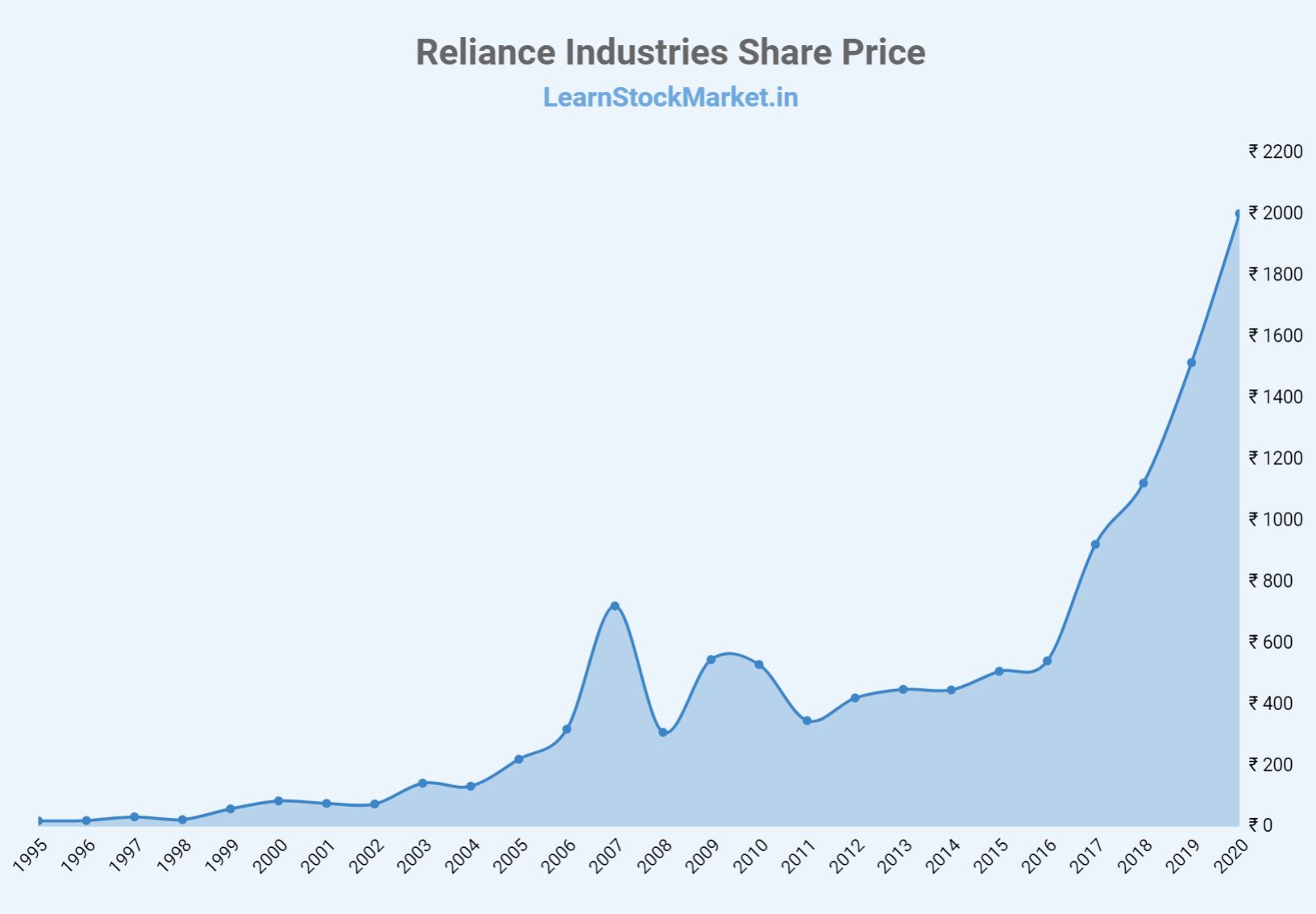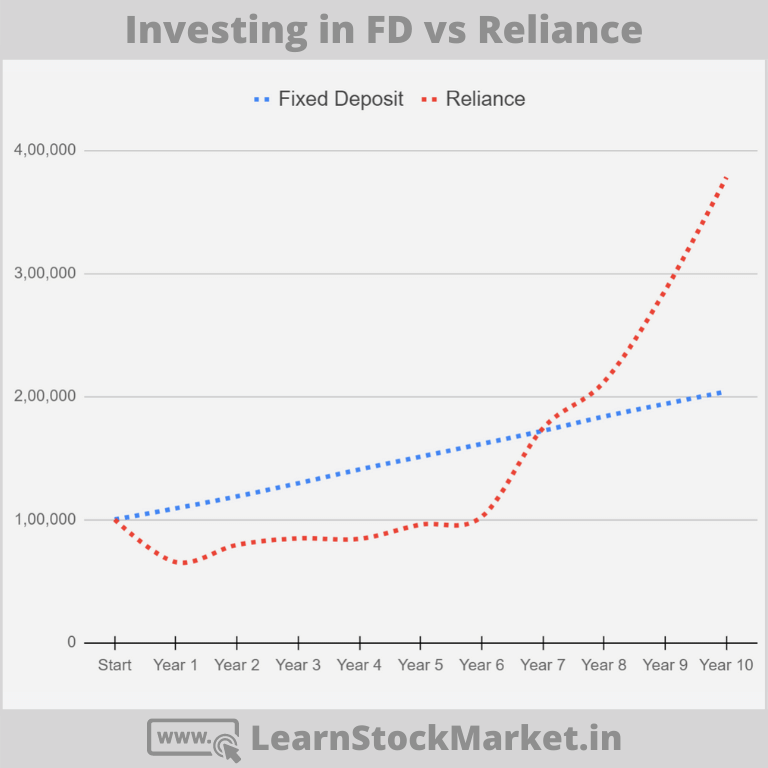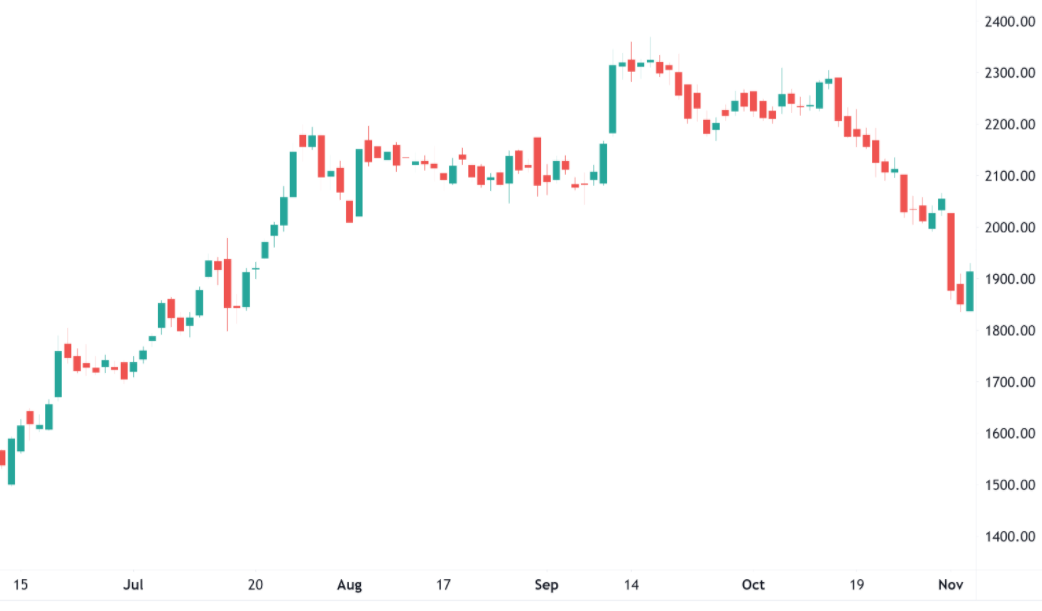Reliance Industries is the most valued company in the Indian stock market. It has created tremendous wealth for its long-term investors, ever since the shares were first issued to the public in 1975.
In this article, we cover the journey of the company from 1995 to 2020.
After adjusting for bonus and splits, the Reliance Industries Share Price has gone up by more than 105 times in the last 25 years. And this does not include the dividends that the company has consistently given out to its investors.
Reliance Industries Share Price History

| Reliance Industries | Share Price | Returns |
| 1995 Share Price | ₹ 19 | |
| 1996 Share Price | ₹ 20 | + 5% |
| 1997 Share Price | ₹ 32 | + 60% |
| 1998 Share Price | ₹ 23 | – 28% |
| 1999 Share Price | ₹ 58 | + 152% |
| 2000 Share Price | ₹ 84 | + 45% |
| 2001 Share Price | ₹ 76 | – 10% |
| 2002 Share Price | ₹ 74 | – 3% |
| 2003 Share Price | ₹ 142 | + 92% |
| 2004 Share Price | ₹ 132 | – 7% |
| 2005 Share Price | ₹ 220 | + 67% |
| 2006 Share Price | ₹ 318 | + 45% |
| 2007 Share Price | ₹ 720 | + 126% |
| 2008 Share Price | ₹ 308 | – 57% |
| 2009 Share Price | ₹ 545 | + 77% |
| 2010 Share Price | ₹ 529 | -3% |
| 2011 Share Price | ₹ 346 | -35% |
| 2012 Share Price | ₹ 420 | + 21% |
| 2013 Share Price | ₹ 448 | + 7% |
| 2014 Share Price | ₹ 446 | 0% |
| 2015 Share Price | ₹ 507 | + 14% |
| 2016 Share Price | ₹ 541 | + 7% |
| 2017 Share Price | ₹ 921 | + 70% |
| 2018 Share Price | ₹ 1,121 | + 22% |
| 2019 Share Price | ₹ 1,514 | + 35% |
| 2020 Share Price | ₹ 2,000 | + 32% |
As you can see from the graph and table above, Reliance has performed extraordinarily well in the last 25 years.
Without including dividend, the compounded annualized returns over the last 25 years has been 20.47%.
Those who invested in Reliance Industries at the end of 1995 and stayed invested till the end of 2020, the stock has gone up 105 times – not including dividends.
But the table above highlights a few important things which you should know:
- When the performance of the stock has been subdued (low) for a few years – the returns in the years that followed were huge. The stock fell 28% from the beginning of 1998 to the end of the year. But the next year, the price went up 152%.
- The period between 2005 to the beginning of 2008 was an exception for Reliance and also the stock market in general. But in 2008, Reliance fell 57% – which is its deepest cut in the last 25 years.
- The best period of performance has been the 2015-2020, when the stock has given positive returns each year. This has been achieved in spite of the major stock market crash due to Covid in March 2020.
The biggest takeaway from this is – if you are a long term investor, you cannot expect exceptional performance every year. A few years of good performance, will be followed by price corrections.
A part of the journey to become a successful long term investor – is to ride through and hold good stocks during both good and bad times.
Reliance Share Returns: Compounded and Absolute
How much returns has Reliance Industries given if you bought the share 2 years ago? Or 3, 4, or 5 years ago.
What if you were a very long term investor and held on to the stock for 10-15-20-25 years.
Well, check out the table below.
| CAGR | Absolute | |
| 2 years | 33.57% | 1.78 times |
| 3 years | 29.50% | 2.17 times |
| 4 years | 38.66% | 3.70 times |
| 5 years | 31.58% | 3.94 times |
| 10 years | 14.22% | 3.78 times |
| 15 years | 15.85% | 9.09 times |
| 20 years | 17.18% | 23.81 times |
| 25 years | 20.47% | 105.26 times |
Reliance has compounded at a spectacular rate of 20.47% over a period of 25 years. If you invested 25 years ago, your investment would’ve gone up 105 times – not including dividends.
1 lakh invested in Reliance Industries
Suppose you invested 1 lakh rupees in Reliance, how much would it be over different time periods?
The answer is in the table below:
| Time Period | 1 Lakh Invested |
| 2 years | 1.78 lakhs |
| 3 years | 2.17 lakhs |
| 4 years | 3.70 lakhs |
| 5 years | 3.94 lakhs |
| 10 years | 3.78 lakhs |
| 15 years | 9.09 lakhs |
| 20 years | 23.8 lakhs |
| 25 years | 1.05 crore |
Reliance Share vs FD Returns
What if you opened a fixed deposit of 1 lakh and made another investment of 1 lakh in Reliance Industries.
The results are below. Again, the returns from Reliance does not include dividends.
| Year | Fixed Deposit | Reliance |
| 2010 | 1,00,000 | 1,00,000 |
| 2011 | 1,09,130 | 65,406 |
| 2012 | 1,18,821 | 79,395 |
| 2013 | 1,29,515 | 84,688 |
| 2014 | 1,40,692 | 84,310 |
| 2015 | 1,51,075 | 95,841 |
| 2016 | 1,61,469 | 1,02,268 |
| 2017 | 1,72,093 | 1,74,102 |
| 2018 | 1,83,710 | 2,11,909 |
| 2019 | 1,93,997 | 2,86,200 |
| 2020 | 2,04,027 | 3,78,072 |
| Returns | 7.39 % | 14.22 % |

Some points to be noted:
- The graph above shows why people prefer fixed deposits over investing in the stock market. The value of the FD never goes down, instead it moves upwards in a straight line – as is clearly seen from the blue line in the image.
- There is literally no risk if you open a fixed deposit in a good bank.
- Investing in the stock market is a different game altogether. If you invested exactly 10 years ago in Reliance Industries, the stock price dropped immediately in the year after your investment (2011).
- Look at the red line, it’s volatile. This is when investors begin to get uncomfortable. An investment of 1 lakh in 2010 went down to 65,000 in 2011. A significant notional loss.
- In fact, for the first 7 years, your returns from Reliance Industries would’ve been lower than a fixed deposit.
- In such situations, investors tend to get worried and most people would either book loss in the first few years when the stock does not move or get out of the stock when they get their invested amount back.
- In the example above, if an investor invested 1 lakh in 2010, he got his investment back only in the 6th year (2016). If the investors got out of the stock here, he would lose the big gains that Reliance gave between 2017 – 2020.
- Another common mistake investors do, is booking out after a small 10-20% gain. If profit was booked in 2017, the investor would once again lose-out on the big gains that Reliance gave between 2017-2020.
- After a 8-10 year long consolidation, Reliance finally gave a break out in 2017 after the launch of the mobile network Jio.
- Over a 10-year period, fixed deposits would’ve given you 7.39% returns, while Reliance – even though it did not give any returns for the first 7 years – ended up giving an average of 14% due to its performance in the last 3 years.
- When dividends are included, Reliance has given nearly double the returns compared to a bank fixed deposit.
Why did Reliance Share Fall Today?
In this section, whenever the Reliance Share Price falls more than 5%, we will update this page with reasons for the fall and whether it could be an opportunity or trouble for the stock.
Do note, this is not a buy or sell recommendation. Kindly do your own research and analysis before investing or trading in any stock.
Reliance Share Price fall on November 2nd 2020
These are interesting times. Reliance has crashed by crashed by 8.62% today. The stock opened at 2027 and fell to a close of 1877. A massive crash for India’s most valued company.
From a top of 2369 per share in September 2020, the stock price has cracked by more than 20%.

And like always, the fall has come with some bad news and uncertainty around Mukesh Ambani’s health.
There are rumours doing the rounds that Ambani has undergone liver transplant in London. This was combined with the legal battle between Amazon, Reliance and Future group. And finally, the quarterly results weren’t great. Their traditional oil business recorded poor numbers – leading to a significant fall in overall revenue of the company.
Telecom and Retail business continues to grow well.
Personally, I have been holding the Reliance stock from a long time. I bought Reliance after the launch of Jio and kept buying on declines. If you’ve done your research and like the company, it’s during such declines the stock should be accumulated.
However, if the rumours of Ambani’s health turn out to be true. It will be bad news for the company.
Such risks are always present when investing in a stock. What if something suddenly happens to Amazon founder Jeff Bezos? The stock is bound to crash. Same with Reliance. It makes a difference to companies where individuals are very important to the future prospects of a company.
It doesn’t make a difference to professionally run companies like Hindustan Unilever Limited (HUL). But does make a significant difference to Reliance, Kotak Mahindra Bank (Uday Kotak) etc.
As an investor, it’s important to work on asset allocation and risk management. I do not invest more than 75% in equities (rest 25% in fixed deposits etc). I also try not to allocate more than 10% in any single company in the stock market. 10% is on the higher side for well-established large companies. Smaller companies would not exceed 5% of my allocation.
Remember, risk is always involved when you invest in the stock market. And that’s also the reason why it has the potential to give better returns than fixed deposit or other ‘safe’ investments.
Reliance is a fantastic company with tremendous potential in the future. It has disrupted the telecom space and reduced it to 3 players, out of which one is nearly dead (Vodafone Idea). The promoters are also extremely aggressive in the retail business.
The company has investors like Google, Facebook, Qualcomm just to name a few. And it’s worth remembering that these companies invested in Reliance during Corona-virus led global recession.
Big money is made when you invest in crisis. The March 2020 crash was an example. How many had the guts to buy in the last week of March? Very few. But that’s where big money is made. During the crisis or in the initial phases of recovery.


Leave a Comment